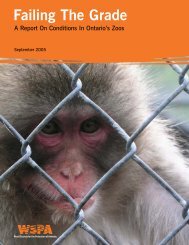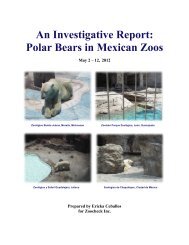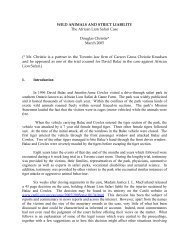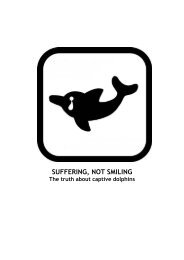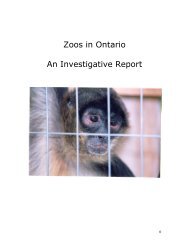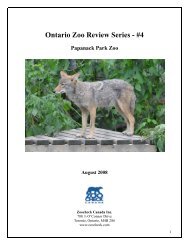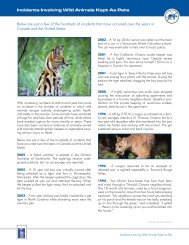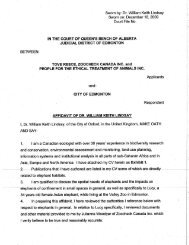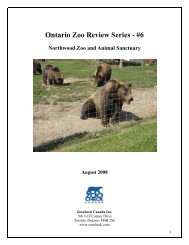Driven By Demand - Whale and Dolphin Conservation Society
Driven By Demand - Whale and Dolphin Conservation Society
Driven By Demand - Whale and Dolphin Conservation Society
Create successful ePaper yourself
Turn your PDF publications into a flip-book with our unique Google optimized e-Paper software.
11The hunts todayShizuoka PrefectureDrive hunts began in Shizuoka Prefecture in the17th Century, mainly off the coast of the IzuPeninsula. 20 After World War II, five towns in thisPrefecture still conducted drive hunts, almostexclusively for striped dolphins. In the 1950s,declines in striped dolphins were first witnessed<strong>and</strong>, as a result, a licensing system wasimplemented that restricted the number ofhunting teams <strong>and</strong> limited the hunting season toSeptember to March. 21 <strong>By</strong> the late 1960s, onlytwo locations in Shizuoka Prefecture (Kawana <strong>and</strong>Futo) were permitted to drive <strong>and</strong> l<strong>and</strong> dolphins.Kawana conducted its final drive in 1983, leavingFuto as the only town in the Prefectureconducting drive hunts in its coastal waters. 22 Inspite of increased regulation of the drive hunts, itwas not until 1993 that the first catch limits wereimposed. 23Shizuoka Prefecture operates under a quota of600 dolphins a year, consisting of 455 spotteddolphins, 75 bottlenose dolphins <strong>and</strong> 70 stripeddolphins. 24 In spite of this, Futo suspended drivehunting after 1999, perhaps as a result of thedecline of the industry. However, evidently inresponse to persistent dem<strong>and</strong>s from theaquarium industry 25 , Futo conducted its first drivehunt in five years on November 11, 2004, drivingover 100 bottlenose dolphins into Futo harbour. 26Fourteen dolphins were selected by six differentaquaria <strong>and</strong> five were slaughtered <strong>and</strong> used for“research” purposes <strong>and</strong> human consumption. Atleast four other dolphins died of suffocation orshock, <strong>and</strong> the surviving dolphins were reportedlyreleased, one having been fitted with a radiotransmitter. 27 As many of these dolphins werereleased with serious injuries, their continuedsurvival was severely compromised <strong>and</strong> reportssuggest that bodies were recovered from theharbour during the night of the release. 28 It isanticipated that future hunts will occur in Futowith the aim of supplying dolphins for theaquarium industry. A November 2004 article inthe Izu Shimbun newspaper quoted the managerof the Futo Branch of the Ito City FishingCooperative as saying: “I'm glad we were able tohave the hunt. I think it was a good experience forthe fishermen… This year isn't the end, so I'd like tothink about the future.” 29 The revitalization of theFuto hunt to meet the dem<strong>and</strong>s of the aquariumindustry is an unfortunate turnaround for a townthat was becoming better known for its dolphinwatching opportunities than its hunting.Wakayama PrefectureDrive hunts in Wakayama Prefecture did not fullybegin until 1969, with the driving of short-finnedpilot whales at Taiji. The hunt exp<strong>and</strong>ed in 1973 toinclude striped dolphins. Following declines instriped dolphins in the 1980s, Taiji fishermenturned their attention to other species such asbottlenose, spotted <strong>and</strong> Risso´s dolphins. 30 In1993, a limited season (October to April) wasimposed on Taiji's drive hunts, with an annualcatch quota of 2,380 animals. This includes 450striped dolphins, 890 bottlenose dolphins, 400spotted dolphins, 300 Risso's dolphins, 300 shortfinnedpilot whales <strong>and</strong> 40 false killer whales. 31 InTaiji's 2003-2004 drive hunt season, 1,165 dolphinswere killed <strong>and</strong> 78 captured alive for the aquariumtrade. 32 In 2000, 2,009 dolphins were killed <strong>and</strong> 68were captured alive; in 2001, 1,191 dolphins werekilled <strong>and</strong> 28 were captured alive; <strong>and</strong>, in 2002,1,935 dolphins were killed <strong>and</strong> 73 were capturedalive. 33 In spite of concerns raised about thepossible impact on the populations targeted 34 , theoverall numbers taken remain high, with increasingnumbers of animals taken alive.Nagasaki PrefectureUntil relatively recently, drive hunts were alsocarried out in the village of Katsumoto, Iki Isl<strong>and</strong>,Nagasaki Prefecture, starting in 1910. Between1976 <strong>and</strong> 1982, 4,141 bottlenose dolphins, 466Pacific white-sided dolphins, 953 false killerwhales <strong>and</strong> 525 Risso's dolphins were killed. 35 Therelease of video footage of the Iki Isl<strong>and</strong> hunts inthe 1980s resulted in an international outcry overthe killings. Whether this had an impact onbringing about an end to the hunts is difficult toassess, although environmentalist <strong>and</strong> broadcasterHardy Jones, who has been documenting thehunts for several decades, believes publicbroadcast of them brought about an end to the IkiIsl<strong>and</strong> hunts. 36 Katsumoto residents report achange in attitude away from the dolphins aspests as the primary factor in ending the hunts. 37Large catches at Katsumoto ceased around 1986,although the town maintained an annual quota of50 until 1995 38 <strong>and</strong> investigations by a Japanesenon-governmental organization, the Elsa NatureConservancy, revealed that 20 dolphins werecaptured alive in 1996. 39 No drive has beenrecorded or reported since then. However,recent interviews with fisheries cooperativeofficials in Katsumoto indicate interest in resumingthe drive hunts in order to capture live dolphinsfor the aquarium industry. 40





